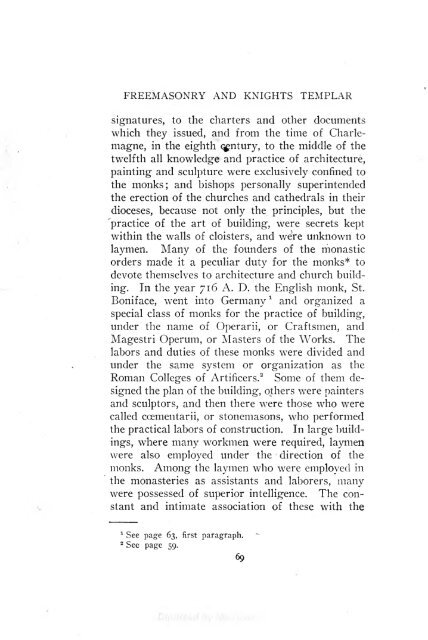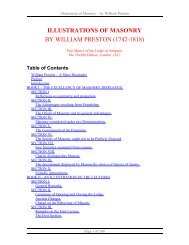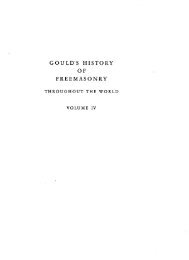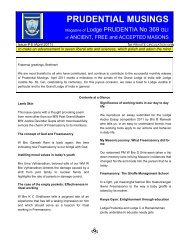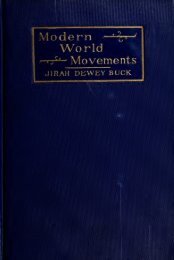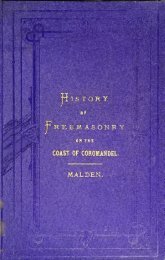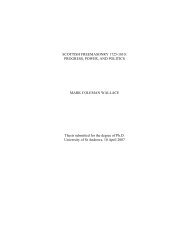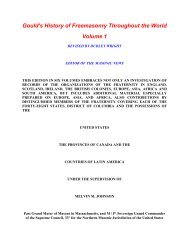- Page 1 and 2:
SoftTHE ORIGINFreemasonry*OFandKnig
- Page 4 and 5:
CONTENTSPREFACEFreemasonryPAGEjAnci
- Page 6 and 7:
HISTORICAL INDEXPAGEAaron .........
- Page 8:
HISTORICALINDEX.PAGEOlympiad !5Pada
- Page 12 and 13:
FREEMASONRY.The true history of isF
- Page 14 and 15:
FREEMASONRY AND KNIGHTS TEMPLAR1of
- Page 16 and 17:
FREEMASONRY AND KNIGHTS TEMPLARan i
- Page 18 and 19:
FREEMASONRY AND KNIGHTS TEMPLARbere
- Page 20 and 21:
FREEMASONRY AND KNIGHTS TEMPLARor M
- Page 22 and 23:
FREEMASONRY AND KNIGHTS TEMPLAROn h
- Page 24 and 25:
FREEMASONRY AND KNIGHTS TEMPLARress
- Page 26 and 27:
FREEMASONRY AND KNIGHTS TEMPLARprio
- Page 28 and 29:
FREEMASONRY AND KNIGHTS TEMPLARcivi
- Page 30 and 31: FREEMASONRY AND KNIGHTS TEMPLARRame
- Page 32 and 33: FREEMASONRY AND KNIGHTS TEMPLARJose
- Page 34 and 35: FREEMASONRY AND KNIGHTS TEMPLARset
- Page 36 and 37: FREEMASONRY AND KNIGHTS TEMPLARthe
- Page 38 and 39: FREEMASONRY AND KNIGHTS TEMPLAReon,
- Page 40 and 41: FREEMASONRY AND KNIGHTS TEMPLARful"
- Page 42 and 43: FREEMASONRY AND KNIGHTS TEMPLARhire
- Page 44 and 45: FREEMASONRY AND KNIGHTS TEMPLARacco
- Page 46 and 47: FREEMASONRY AND KNIGHTS TEMPLARIsra
- Page 48 and 49: FREEMASONRY AND KNIGHTS TEMPLARand
- Page 50 and 51: FREEMASONRY AND KNIGHTS TEMPLAROne
- Page 52 and 53: FREEMASONRY AND KNIGHTS TEMPLAR"& W
- Page 54 and 55: FREEMASONRY AND KNIGHTS TEMPLARthe
- Page 56 and 57: FREEMASONRY AND KNIGHTS TEMPLARThis
- Page 58 and 59: FREEMASONRY AND KNIGHTS TEMPLARwall
- Page 60 and 61: FREE&ASONRY AM) KNIGHTS TEMPLARpass
- Page 62 and 63: FREEMASONRY AND KNIGHTS TEMPLARgold
- Page 64 and 65: FREEMASONRY AND KNIGHTS TEMPLARWhat
- Page 66 and 67: FREEMASONRY AND KNIGHTS TEMPLARHebr
- Page 68 and 69: FREEMASONRY AND KNIGHTS TEMPLARpies
- Page 70 and 71: FREEMASONRY AND KXKillTS TEML'LAKAn
- Page 72 and 73: FREEMASONRY AND KNIGHTS TEMPLARCaes
- Page 74 and 75: FREEMASONRY AND KNIGHTS TEMPLARor p
- Page 76 and 77: FREEMASONRY AND KNIGHTS TEMPLARking
- Page 78 and 79: FREEMASONRY AND KNIGHTS TEMPLARitab
- Page 82 and 83: FREEMASONRY AND KNIGHTS TEMPLARGerm
- Page 84 and 85: FREEMASONRY AND KNIGHTS TEMPLARther
- Page 86 and 87: FREEMASONRY AND KNIGHTS TEMPLARthe
- Page 88 and 89: FREEMASONRY AND KNIGHTS TEMPLARsour
- Page 90 and 91: FREEMASONRY AND KNIGHTS TEMPLARof r
- Page 92 and 93: FREEMASONRY AND KNIGHTS TEMPLARRite
- Page 94 and 95: FREEMASONRY AND KNIGHTSTEMPLARThe A
- Page 96 and 97: FREEMASONRY AXI) KXKIHTS TEMPLARDeg
- Page 98 and 99: FREEMASONRY AND KNIGHTS TEMPLARbut
- Page 100 and 101: 'FREEMASONRY AND KNIGHTS TEMPLARROY
- Page 102 and 103: FREEMASONRY AND KNIGHTS TEMPLARcapt
- Page 104 and 105: FREEMASONRY AND KNIGHTS TEMPLARand
- Page 106 and 107: FREEMASONRY AND KNIGHTS TEMPLARwas
- Page 108 and 109: FREEMASONRY AND KNIGHTS TEMPLARincl
- Page 110 and 111: FREEMASONRY AND KNIGHTS TEMPLARso s
- Page 112 and 113: FREEMASONRY AND KNIGHTS TEMPLARtrue
- Page 114 and 115: FREEMASONRY AND KNIGHTS TEMPLARto u
- Page 116 and 117: FREEMASONRY AM) KNIGHTS TEMPLARCryp
- Page 118 and 119: FREEMASDXkV AXD KNIGHTSYr:.\;i'LARS
- Page 120 and 121: FREEMASONRY AND KNIGHTS TEMPLARDesi
- Page 122 and 123: FREEMASONRY AND KNIGHTS TEMPLARComm
- Page 124 and 125: FREEMASONRY AND KNIGHTS TEMPLAReven
- Page 126 and 127: FREEMASONRY AND KNIGHTS TEMPLARthey
- Page 128 and 129: FREEMASONRY AXI) KNIGHTS TEMPLARKin
- Page 130 and 131:
FREEMASONRY AND KNIGHTS TEMPLARdiss
- Page 132 and 133:
FREEMASON KY VND KNIGHTS TEMPLARThe
- Page 134 and 135:
FREEMASONRY AND KNIGHTS TEMPLARwas
- Page 136 and 137:
FREEMASONRY AND KNIGHTS TEMPLARbeca
- Page 138 and 139:
FREEMASONRY AND KNIGHTS TEMPLARhort
- Page 140 and 141:
FREEMASONRY AND KNIGHTS TEMPLARhist
- Page 142 and 143:
FREEMASONRY AND KNIGHTS TEMPLARof h
- Page 144 and 145:
FREEMASONRY AND KNIGHTS TEMPLARberi
- Page 146 and 147:
FREEMASONRY AND KNIGHTS TEMPLARwhat
- Page 148 and 149:
FREEMASONRY AND KNIGHTS TEMPLARwort
- Page 150 and 151:
FREEMASONRY AND KNIGHTS TEMPLARhe w
- Page 152 and 153:
FREEMASONRY AND KNIGHTS TEMPLARthe
- Page 154 and 155:
FREEMASONRY AND KNIGHTS TEMPLARfait
- Page 156 and 157:
FREEMASONRY AM) KXKiHTS TEMPLARbann
- Page 158 and 159:
IKKKMASUXKVAXU KX1GHTS TEMPLARBATTL
- Page 160 and 161:
FREEMASONRY AND KNIGHTS TEMPLARthe
- Page 162 and 163:
FREEMASONRY AND KNIGHTS TEMPLARHe w
- Page 164 and 165:
FREEMASONRY AND KNIGHTS TEMPLAR4. T
- Page 166 and 167:
FREEMASONRY AND KNIGHTS TEMPLARin t
- Page 168:
FREEMASONRY AND KNIGHTS TEMPLARBona
- Page 172 and 173:
Supplemental Encyclopaedia of Ancie
- Page 174 and 175:
SUPPLEMENTAL ENCYCLOPEDIAAholiab A
- Page 176 and 177:
SUPPLEMENTALENCYCLOPAEDIAmidway bet
- Page 178 and 179:
SUPPLEMENTAL ENCYCLOPEDIAcountries
- Page 180 and 181:
SUPPLEMENTAL ENCYCLOPEDIAbetween an
- Page 182 and 183:
SUPPLEMENTAL ENCYCLOPAEDIAterity se
- Page 184 and 185:
SUPPLEMENTAL ENCYCLOPAEDIAChaldeaA
- Page 186 and 187:
SUPPLEMENTAL ENCYCLOPAEDIAThe kingd
- Page 188 and 189:
SUPPLEMENTAL ENCYCLOPAEDIAthe daugh
- Page 190 and 191:
SUPPLEMENTAL ENCYCLOPEDIAgreat hors
- Page 192 and 193:
SUPPLEMENTAL ENCYCLOPAEDIAthe north
- Page 194 and 195:
SUPPLEMENTAL ENCYCLOPAEDIA.Jethro "
- Page 196 and 197:
SUPPLEMENTAL ENCYCLOPAEDIAaccording
- Page 198 and 199:
SUPPLEMENTAL ENCYCLOPAEDIAMiddle Ag
- Page 200 and 201:
SUPPLEMENTAL ENCYCLOPEDIAby persecu
- Page 202 and 203:
SUPPLEMENTAL ENCYCLOPAEDIAvillages
- Page 204 and 205:
isSUPPLEMENTAL ENCYCLOPEDIAcities.
- Page 206 and 207:
SUPPLEMENTAL ENCYCLOPEDIARephidim A
- Page 208 and 209:
SUPPLKMKXTAi,r.A CYCLOPEDIAseems to
- Page 210 and 211:
SUPPLEMENTAL EXCYCLOP/ED1 AHigh. In
- Page 212 and 213:
SUPPLEMENTAL ENCYCLOPAEDIA*Tadmor A
- Page 214 and 215:
SUPPLEMENTAL ENCTCD >IVEDIAplace of
- Page 216 and 217:
SUPPLEMENTAL ENCYCLOPAEDIAthe death


